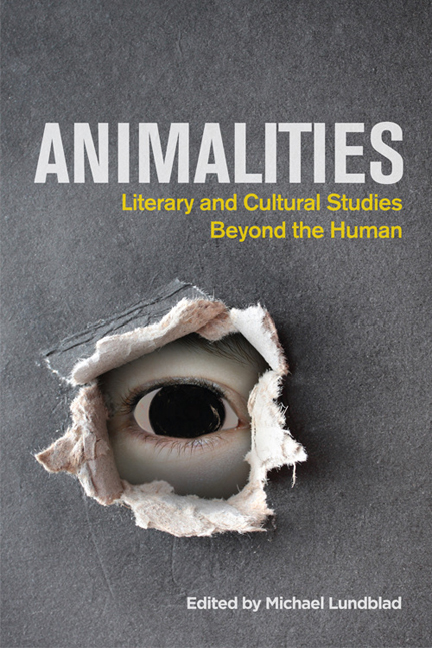Book contents
- Frontmatter
- Contents
- List of Figures
- Acknowledgments
- Introduction: The End of the Animal – Literary and Cultural Animalities
- 1 Each Time Unique: The Poetics of Extinction
- 2 Posthuman New York: Ground Zero of the Anthropocene
- 3 J. G. Ballard's Dark Ecologies: Unsettling Nature, Animals, and Literary Tropes
- 4 Staging Humanimality: Patricia Piccinini and a Genealogy of Species Intermingling
- 5 “Sparks Would Fly”: Electricity and the Spectacle of Animality
- 6 The Nature of Birds, Women, and Cancer: Terry Tempest Williams's Refuge and When Women Were Birds
- 7 Animality, Biopolitics, and Umwelt in Amitav Ghosh's The Hungry Tide
- 8 Looking the Beast in the Eye: Re-animating Meat in Nordic and British Food Culture
- 9 Love Triangle with Dog: Whym Chow, the “Michael Fields,” and the Poetic Potential of Human-Animal Bonds
- 10 Bestial Humans and Sexual Animals: Zoophilia in Law and Literature
- Notes on Contributors
- Index
4 - Staging Humanimality: Patricia Piccinini and a Genealogy of Species Intermingling
Published online by Cambridge University Press: 07 December 2017
- Frontmatter
- Contents
- List of Figures
- Acknowledgments
- Introduction: The End of the Animal – Literary and Cultural Animalities
- 1 Each Time Unique: The Poetics of Extinction
- 2 Posthuman New York: Ground Zero of the Anthropocene
- 3 J. G. Ballard's Dark Ecologies: Unsettling Nature, Animals, and Literary Tropes
- 4 Staging Humanimality: Patricia Piccinini and a Genealogy of Species Intermingling
- 5 “Sparks Would Fly”: Electricity and the Spectacle of Animality
- 6 The Nature of Birds, Women, and Cancer: Terry Tempest Williams's Refuge and When Women Were Birds
- 7 Animality, Biopolitics, and Umwelt in Amitav Ghosh's The Hungry Tide
- 8 Looking the Beast in the Eye: Re-animating Meat in Nordic and British Food Culture
- 9 Love Triangle with Dog: Whym Chow, the “Michael Fields,” and the Poetic Potential of Human-Animal Bonds
- 10 Bestial Humans and Sexual Animals: Zoophilia in Law and Literature
- Notes on Contributors
- Index
Summary
In Patricia Piccinini's sculpture The Welcome Guest (Figures 4.1–4.3), a small child of about two or three years old stands on a bed while looking adoringly up at a smiling creature standing in front of her. The creature, slightly taller than the child, has oversized single claws growing out of its feet and hands, and a head, torso, and upper legs reminiscent of both human and ape. We may describe it as both strange and familiar, frightening and interesting. It is in the process of embracing the child, who has begun to open her arms in return. The look and smile they share are loving, calm, and accepting. On the bed's headboard is perched a peacock – as witness, or possibly decoration? The creature's large, sharp-looking claws look both impractical and potentially threatening, the latter in contrast to the friendliness of the embrace. This kind of encounter, where the action is suspended in the sculptural moment, is characteristic of many of Piccinini's works. The outcomes of her intimate humanimal encounters are hard to determine.
In this chapter, I use encounters as the starting point for an investigation of Piccinini's sculptures as part of a genealogy of species intermingling that goes back to much earlier forms of monstrosity and hybridity, such as early modern “monsters” and Victorian “freaks.” While placing Piccinini's work in such a genealogy, I also claim that she breaks with it through facilitating a possibility for ethical engagement with the nonhuman animal “other” that the previous forms of species intermingling do not.
My investigation is thus organized in a two-pronged argument. The first part of the argument is rooted in how I see Piccinini's work taking up what Anat Pick calls “a crisis at the level of the human form.” In Pick's analysis, it is the trauma of transformation from human to nonhuman animal that prompts the crisis of the human form. This crisis is easily recognizable in Piccinini's humanimal forms, which take on a partly, but never wholly, human guise.
- Type
- Chapter
- Information
- AnimalitiesLiterary and Cultural Studies Beyond the Human, pp. 80 - 103Publisher: Edinburgh University PressPrint publication year: 2017



